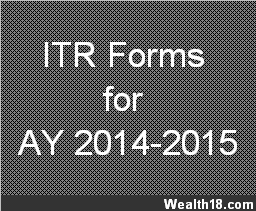As Last date for filing Income tax returns is approaching (31-July), you must to looking into your financials to prepare returns.
It is important to check in which ITR form you should file your IT return. You should check , which Income Tax return (ITR) Form is applicable for you ?
Salaried employees will normally need to file their Income Tax returns in ITR 1 or ITR 2 (depending on the conditions below).
So please read the specific conditions to determine whether you need to file your returns in ITR 1 or ITR 2
| ITR 1 | You can file return in ITR 1if you have Salary income
If you have income from ONE house property (excluding cases where loss is brought forward from previous years.) if you have income from other sources (except income from lottery or from horse races) |
| However, you cannot file return in ITR 1 – if exempt income (income not chargeable to tax) exceed Rs. 5,000. (for e.g Dividends, PPF Interest etc. This condition is important to note
if any income from Capital Gains – (for e.g Sale/ purchase of shares, property etc) if any loss under the head Income from Other Sources, if such person has assets (including financial interest in any entity) located outside India or such person has signing authority in any account located outside India. if claiming any double taxation tax relief under sections 90 or 90 A or 91 of the Income-tax Act, 1961. |
|
| ITR 2 |
If your income doesn’t include Income from Business & profession and you donot meet conditions for ITR 1,then you need to submit return in ITR 2. |
| ITR 3 |
For Individuals/HUFs being partners in firms and not carrying out business or profession under any proprietorship |
| ITR 4 |
For individuals and HUFs having income from a proprietory business or profession |
| ITR 4S |
Sugam – Presumptive Business Income tax ReturnForm No. SUGAM (ITR 4S) is provided for filing Income-tax Return by the persons who are taking advantage of computing their income in terms of section 44AD or section 44AE of the Income-tax Act for computation of their business income based on a percentage of the profit.It may be noted that this return form be used only when the turnover of the business is less than Rs. 1 crore. |
|
The new amendment to Rule 12 of Income-tax Rules now provides that the provisions relating to filing of Income-tax Return in Form SUGAM (ITR 4S) will not apply : and such persons should file return in Form No. 4. |
|
| ITR 5 |
For firms, AOPs and BOIs |
| ITR 6 |
For Companies other than companies claiming exemption under section 11 |
| ITR 7 |
For persons including companies required to furnish return under Section 139(4A) or section 139(4B) or section 139(4C) or section 139(4D)] |
You can download these forms / submit ITR online at link below
https://incometaxindiaefiling.gov.in/
Link to download all ITR Forms & Instructions in pdf (English & Hindi)
https://incometaxindia.gov.in/download_all.asp
ITR 1 / ITR 2 – Exempt Income more than Rs 5000
Last year there was lot of discusion that when to file ITR 1 or ITR 2 and what is the scope for Exempt Income ?
For e.g if HRA is exempt for Rs 5000 or more, whether ITR 2 is applicable etc. The Answer is NO.
However, please note that if EXEMPT Income like – Dividend Income, PPF Interest, Agricultural Income etc is more than Rs 5000, then you need to file ITR 2.

